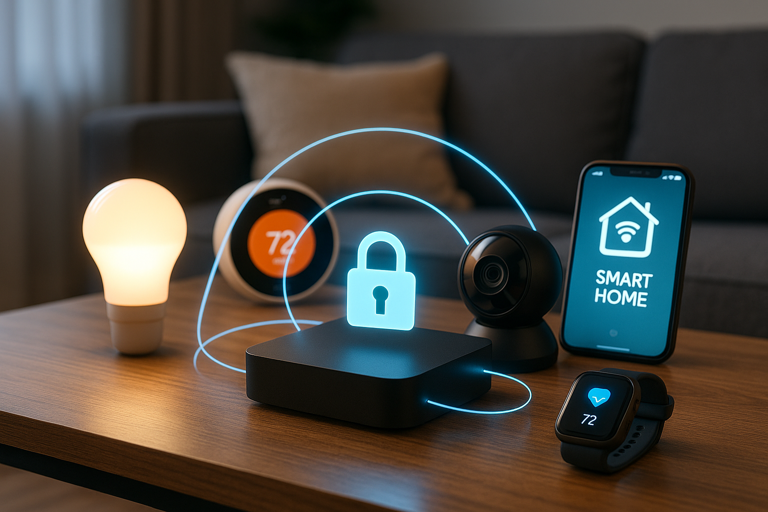This post may contain affiliate links. If you click through and make a purchase, we may earn a commission at no additional cost to you. This helps support our work and allows us to continue providing valuable content. For more information, please see our disclosure policy.

In today’s fast paced IoT world, keeping MQTT (Message Queuing Telemetry Transport) secure is more important than ever. MQTT is one of the most widely used protocols that lets connected devices “talk” to each other – whether it’s a smart thermostat reporting temperature to your phone app, a fitness tracker syncing with your health dashboard, or a security camera sending alerts when someone’s at your door.
But here’s the catch. MQTT was originally designed for trusted, closed networks back in 1999. It wasn’t built with today’s threats in mind, whether it be hackers breaking into smart homes, cybercriminals stealing personal data or malicious software turning devices into attack tools. Without the right protections, attackers could spy on your messages, steal your login details or take control of your devices.
Think about it. If someone hacked your smart home system, they could see when you’re away, unlock doors or access your cameras. In a hospital, insecure medical devices could put patient safety at risk. These aren’t just hypothetical scenarios. Real attacks have already happened, affecting millions of people.
This is why securing MQTT matters to anyone who uses smart devices. Strong authentication keeps intruders out, encryption scrambles your data and access controls ensure only the right devices have the right permissions.
While this guide focuses on MQTT security, the fundamentals (authentication, encryption and access control) are essential across IoT security as a whole. Whether you’re setting up a smart home, using wearables or working with industrial IoT systems, these principles provide a solid foundation for keeping your digital world safe.

Understanding MQTT Security Challenges
While it’s clear that securing MQTT is vital, doing so comes with its own set of hurdles:
- Unprotected Data Transmission: MQTT runs on TCP, which transmits data in plain text unless paired with encryption like TLS. This means sensitive information like your home’s temperature patterns, security codes or personal routines could be exposed if not encrypted.
- Password Vulnerabilities: In its basic form, MQTT sends login information as plain text, which is like shouting your password across a crowded room. While encryption can fix this problem, some very constrained devices may still struggle with TLS, though lightweight options are improving.
- Complex Access Management: Deciding who gets access to what can be tricky. You need to verify each device and set rules for which topics it can publish or subscribe to. Scaling this across dozens or hundreds of devices gets complicated.
Overcoming these challenges requires a layered approach to security. This means using multiple protective measures together, including strong user verification, secure communication channels and clear access control policies. By addressing these issues head-on, you can build a safer, more reliable smart device environment where your data and devices stay protected.
The good news is that these same security principles work across all types of connected devices, whether they use MQTT or other communication methods. Understanding these basics gives you the foundation to secure your entire digital ecosystem.
Authentication: Proving Devices Are Who They Say They Are
Authentication is like having a secure lock on your front door. It makes sure only the right people (or devices) can get into your smart home network or IoT system. When it comes to MQTT and other smart device communications, authentication ensures that only your authorized devices can connect and share information.
How Devices Prove Their Identity
Just like you might show an ID card to prove who you are, smart devices need ways to prove their identity before they can join your network. Here are the most common methods.
| Authentication Method | How It Works | Pros | Cons | Best For |
|---|---|---|---|---|
| Username & Password | Device enters a username and password to connect | Easy to set up and understand | Can be stolen if not protected | Basic smart home setups, testing |
| Security Tokens | Device uses special temporary “keys” that change regularly | More secure than fixed passwords | Requires more setup and management | Business systems, advanced users |
| Digital Certificates | Like a digital ID card that’s very hard to fake | Highest security level available | Complex to set up and maintain | High security situations, professional installations |
| Modern Authentication (OAuth) | Uses secure login services like those from Google or Microsoft | Industry standard, very flexible | More complex setup required | Systems that connect to online services |
These authentication methods work across all types of smart devices and communication methods, whether your devices use MQTT, other protocols, or connect through different apps and services. The key is picking the right security level for your needs and device capabilities.
Digital Certificates: The Gold Standard
Think of digital certificates like high-tech ID cards that are nearly impossible to counterfeit. When a device wants to connect to your system, it presents its certificate and your system checks with a trusted Certificate Authority (CA) to make sure the certificate is real and hasn’t been revoked.
How It Works In a Nutshell
- Getting Certified: Each device gets its own unique digital certificate from a trusted source.
- Proving Identity: When connecting, the device shows its certificate.
- Verification: Your system checks that the certificate is valid and trustworthy.
- Secure Connection: Once verified, the device can communicate securely.
This method provides the strongest security but requires more technical knowledge to set up and maintain. For high security IoT deployments, it’s worth the effort though.
Authorization: Controlling What Devices Can Do
Once your devices prove they’re legitimate through authentication, you need to control what they’re allowed to do. Authorization is not too dissimilar to granting different people different levels of access to your house. Your family gets full access, the babysitter can enter certain rooms and the delivery person can only access the front porch.
Access Control Lists (ACLs)
Access Control Lists are straightforward rules that specify exactly which devices can do what.
For example, you might set up rules like:
- Only your temperature sensors can report temperature data.
- Only your phone app can receive temperature updates.
- Your smart thermostat can both read temperature data and control heating/cooling.
Here’s how this might look in practice:
| Device / Function | Permission (ACL) | MQTT Action | What It Can Access |
|---|---|---|---|
| Temperature Sensor | Write only | Publish | Home temperature readings |
| Phone App | Read only | Subscribe | Home temperature readings |
| Smart Thermostat | Read & Write | Publish & Subscribe | Temperature data and heating controls |
This approach ensures that even if an unauthorized device somehow gets onto your network, it can’t access or control systems it shouldn’t touch.
Role Based Access Control
Role based access control (RBAC) simplifies permission management by grouping similar devices together. Instead of setting individual rules for every device, you create roles like “sensors”, “controllers” and “monitoring apps”, then assign permissions to each role.
Here’s a simple example:
| Role | What They Can Do | Example Devices |
|---|---|---|
| Sensors | Send readings only | Temperature sensors, motion detectors, door sensors |
| Controllers | Send and receive data, make changes | Smart thermostats, lighting controls, smart locks |
| Monitors | Receive data only | Phone apps, computer dashboards, alert systems |
| Administrators | Full access to everything | Your main control app, security system |
This method makes it much easier to manage permissions as you add more devices. Instead of configuring each new temperature sensor individually, you just assign it to the “sensors” role and like magic, it will automatically get the right permissions.
Encryption
Encryption scrambles your data so that even if someone intercepts it, they can’t understand what it says. This protection is crucial for all smart devices, regardless of how they communicate.
Protecting Data in Transit
When your smart devices send information, it travels across networks where it could potentially be intercepted. Encryption ensures this data remains private and secure.
What Encryption Protects Against
- Eavesdropping: Prevents strangers from reading your private data.
- Data Tampering: Stops attackers from changing your messages.
- Impersonation: Confirms you’re talking to the real device, not a fake one.
MQTT typically runs on:
| Type | Port | Encryption | Use Case |
|---|---|---|---|
| MQTT (basic) | 1883 | None | Testing only – insecure |
| MQTT over TLS | 8883 | Encrypted | Always use for production |
| MQTT over WebSockets (WSS) | 443 | Encrypted | Cloud/browser IoT apps |
The same encryption principles that protect MQTT also safeguard other smart device communications, whether they’re using different protocols or connecting through various apps and services.
Encrypting the Message Itself
While encrypting the connection protects data as it travels, you can add another layer of security by encrypting the actual message content.
Why This Matters
- Even if someone breaks the outer security, your actual data stays protected.
- Messages remain secure even when passing through multiple systems.
- Provides backup protection if other security measures fail.
Simple Integrity Checks
- Message Verification: Ensures the message hasn’t been altered during transmission.
- Authenticity Confirmation: Proves the message really came from the claimed sender.
- Freshness Protection: Prevents old messages from being replayed maliciously.
These extra security measures apply to all types of smart device communications and represent best practices for protecting sensitive information in our connected world.
Common Security Vulnerabilities to Watch Out For
Understanding common security weaknesses helps you protect your smart devices much more effectively. Keep in mind, these vulnerabilities affect many types of connected devices, not just those using MQTT.
Dangerous Default Settings
One of the biggest security risks comes from using devices with their factory default settings. Many MQTT brokers and IoT devices ship with security features turned off or configured in unsafe ways to make initial setup easier.
Common Risky Defaults
- Default Passwords: Many devices come with simple passwords like “admin” or “12345” that everybody knows.
- No Encryption: Devices often start with security features disabled.
- Open Access: Some devices allow anyone to connect until you specifically set restrictions.
- Unnecessary Features: Extra services running that you don’t need but that create security risks.
Simple Fixes
- Always change default passwords immediately after setup.
- Enable all available security features.
- Turn off any services or features you don’t actually use.
- Regularly check for and install security updates.
Software Vulnerabilities and Updates
Believe it or not, even very well designed devices can have security flaws in their software that get discovered over time. Outdated brokers or clients may contain issues, such as buffer overflow bugs (e.g. CVE-2018-11993). These vulnerabilities can potentially allow attackers to take control of devices or steal information.
Why This Matters
- Hackers actively look for and exploit known software flaws.
- Unpatched devices become easy targets for automated attacks.
- Security holes can affect entire categories of devices from the same manufacturer.
Staying Protected
- Set up automatic updates when available.
- Regularly check manufacturer websites for security announcements.
- Replace devices that no longer receive security updates.
- Consider the manufacturer’s track record for security support before buying.
Network Based Attacks
Your smart devices can also be targeted through your network connection. Attackers might try to overwhelm your devices, trick them into connecting to fake services or exploit weaknesses in network protocols.
Common Attack Types
- Overwhelm Attacks: Flooding devices with so many requests they can’t function normally.
- Fake Services: Setting up malicious servers that pretend to be legitimate services.
- Traffic Interception: Capturing and analyzing network communications.
- Network Mapping: Scanning your network to find vulnerable devices.
Protection Strategies
- Use strong network passwords and modern security protocols
- Separate smart devices from computers containing sensitive personal data
- Monitor network traffic for unusual patterns
- Keep network equipment (i.e. routers, access points etc.) updated with the latest firmware
Real World Examples: When Smart Device Security Goes Wrong
These examples show how security problems with one type of device can affect much larger systems, demonstrating why good security practices matter for everyone.
Mirai Botnet Attack (2016)
In 2016, hackers took control of millions of smart devices, such as cameras, routers and other connected gadgets by using default passwords that people never changed. These compromised devices were then used to overwhelm major Internet services, causing websites like Twitter, Netflix and Reddit to go offline for hours.
The attack worked by creating a massive “robot army” of compromised devices called the Mirai botnet. Each infected device contributed to flooding Internet infrastructure with fake traffic, eventually bringing down services that millions of people relied on daily.
What We Learned
- Always change default passwords on any smart device.
- One unsecured device can contribute to problems affecting millions of people.
- Strong passwords and good security practices protect everyone, not just you.
- Regular updates and security patches are crucial for preventing exploitation.
Tesla Model S Vulnerability (2016)
In 2016, security researchers from Keen Security Lab discovered a vulnerability in the Tesla Model S that showed they could remotely control a Tesla vehicle by exploiting weaknesses in how the car’s systems communicated with each other. They were able to apply the brakes, manipulate displays and access other important functions from miles away.
The researchers found vulnerabilities that ultimately gave them access to the vehicle’s internal Controller Area Network (CAN) bus. By injecting unauthorized messages into this system, they could send commands to critical vehicle components.
What We Learned
- Multiple layers of protection provide backup if one security measure fails.
- Security problems can have real physical consequences, not just digital ones.
- Strong encryption and device verification prevent remote control attacks.
- Regular security check-ups are essential for any connected system.
The Future of IoT Security
As smart devices become more common and sophisticated, security measures will continue to evolve to meet new challenges. The next wave of IoT protection is already taking shape.
Emerging Security Technologies
- Artificial Intelligence for Security: AI systems are getting better at detecting unusual device behavior and identifying potential threats before they cause damage. These systems can learn what’s normal for your devices and alert you when something seems wrong.
- Automated Security Management: Future systems will be able to automatically update security settings, manage passwords and respond to threats without requiring constant human oversight.
- Improved Encryption: New encryption methods are being developed that provide strong security while using less processing power, making advanced security available even on simple devices.
Industry Collaboration and Standards
- Universal Security Standards: Technology companies are working together to create common security standards that work across different brands and types of devices.
- Better Security by Design: Manufacturers are building security features into devices from the ground up, rather than adding them as an afterthought.
- Simplified User Experience: Future security tools will be easier to use, making strong security accessible to everyone regardless of technical expertise.
Preparing for Tomorrow’s Challenges
- Quantum Safe Security: New security methods are being developed to withstand the power of future quantum computers.
- Edge Computing Security: As more processing happens locally on devices rather than in the cloud, new security approaches are needed to protect these distributed systems.
- Privacy Preserving Technologies: New methods allow devices to share necessary information while keeping personal data private and secure.
Smart Devices, Smarter Security
MQTT may be lightweight, but its security matters for everyone – from homeowners with a few smart devices to industries managing thousands of sensors. By applying TLS encryption, authentication and access controls, you can dramatically reduce reduce risks and protect your data in motion.
And here’s the bigger picture: these practices don’t just apply to MQTT. They’re the same principles that protect all IoT systems. By securing one protocol, you’re building the habits that will keep your entire connected ecosystem safer for years to come.

